There is no doubt that Betta fish are one of the most popular pet fish around the world. In addition to their beautiful colours, they have many distinctive features and come in many shapes and sizes, which adds aesthetic appeal to your aquarium. Betta fish need to have plants around them to thrive. These plants serve more than a purpose of simply providing them with nutrients but also help provide a suitable habitat for them.
It is necessary to design an aquarium suited to Bettas if you want to care for them successfully. Considering the right water conditions, tank mates, and decorations, such as plants, is crucial.
Below you will find an assortment of the best plants for betta fish to choose from, including both fake and live options. Additionally, plants enhance the beauty of your tank and make it look more realistic.
Fake Betta Fish Plants
Beginners often use artificial plants for their betta fish. Whether you want to keep plants alive or not, that’s fine. The silk plant should be chosen over the plastic plant unless the plastic is soft and not jagged.
Silk plants’ movement and performance are also similar to those of live plants. In addition to being relatively inexpensive, they have no risk of rotting, dying, being eaten by tankmates, and carrying disease. While they are helpful for oxygenating water and absorbing betta waste, they do not have all the benefits of the best live plant.
Faux plastic and silk plants are available in many colours, but you should choose those that look like the live plants recommended below. The ideal way to recreate a natural betta fish ecosystem is to have a healthy mix of foreground, midground, and background and floating silk plants. You don’t want to push your betta too far and make it difficult for it to get air and feed at the surface.
Fake Plant Care
Always rinse new plastic or silk plants in hot water before adding them to your betta’s tank to prevent bacteria growth. As well as attracting algae, artificial plants can collect faeces on leaves and crevices. Clean your fake plants and other decorations thoroughly when you clean your tank (hot water).
Fake Plants Pros & Cons
Pros:
- A great deal of variety can be used to achieve a variety of looks
- It does not need to match the water parameters of your aquarium (temp, pH, substrate)
- They are inedible to fish
- Pests and diseases are unlikely to be introduced
Cons:
- You won’t be able to keep your aquarium’s water balanced if you use this
- They look tacky most of the time
- Your tank could be leaking chemicals
- Your water shouldn’t be oxygenated
- Reducing nitrates is not a good idea
- Algae growth shouldn’t be inhibited
Plants from synthetic or fake materials are typically made from plastic but can also come in silk or other textiles.
You can choose from a wide variety of synthetic plants, many of which are available in bright colours, so your aquarium can look like a natural plant or add a unique aesthetic.
Plants that are not living require far less maintenance than living plants, which is their primary advantage.
It doesn’t matter what substrate, temperature, or pH you place your synthetic plants in; they don’t require fertiliser, either.
A fake plant also has the advantage that the fish can’t eat it. Not only do these plants not get damaged like natural plants, but they also don’t clog up your tank’s filter as they might if they were natural plants.
Additionally, synthetic plants are usually less expensive than real ones, especially if you are starting from scratch when setting up a large tank.
Aside from that, they can be placed straight into the tank and have little chance of introducing diseases or parasites.
In contrast to natural plants, synthetic plants don’t provide the same biological benefits for your aquarium. They can’t absorb nitrates or carbon dioxide, nor can they be produced, inhibit algae growth, or be used as a food source for fish.
Some plastics can leach chemicals into the water and may harm betta fish, so it’s essential to be careful about synthetic plants’ materials.
You should buy silk plants if you want to make fake plants.
Live Betta Fish Plants
The maintenance required for live plants varies, and they can also provide many other benefits. It is possible to add live plants to your betta fish tank to provide more oxygen to the water and to reduce the harmful ammonia and nitrate levels that can cause stress or even death to your fish. Like fake plants, they can even be used to provide hiding spots for betta fish and to prevent them from becoming bored. It is possible to become bored, bite your fins, and suffer other undesirable effects.
Live plants can also be cheaper in the long run when correctly propagated and cared for. It is even possible for more advanced aquarists to have a separate aquarium containing only living plants to support their community tanks or to view beautiful aquascapes. Plants propagated can be moved around the tank or into other tanks to begin new growth.
If you see a plant that seems to be dying, do not buy it. Buying plants from community tanks is not recommended. Bettas can become sick or die from common aquatic diseases carried by these live plants, so they must be quarantined before introducing them.
Live Plants Pros & Cons
Pros:
- Ensure the balance of the water quality in your aquarium
- Maintain a healthy level of nitrates
- Keeping the water column’s carbon dioxide level low
- Algae growth will be inhibited
- Make sure your betta fish’s water is oxygenated
- Provide your betta fish with a realistic environment
Cons:
- Keeping them up to date is necessary
- Quarantining can prevent the introduction of unwanted pests into your aquarium.
Live plants in your aquarium can balance the water’s quality as living, breathing organisms.
In addition to absorbing nitrates and carbon dioxide, aquatic plants also oxygenate the water. Your betta will also benefit from a healthier environment if you have natural plants in the tank that inhibit algae growth.
The lives of plants also change over time, which can either be positive or negative. This means that as time passes, the landscape of your tank changes.
Nevertheless, you’ll have to prune your plants back to avoid crowding out the fish or crowding the filter intakes.
Introducing diseases and parasites into your aquarium when introducing a live aquarium plant from another tank with an outbreak of disease is possible.
This risk can be dramatically reduced by quarantining new plants.
In general, I think live aquatic plants are better for betta fish. In this case, the pros outweigh the cons.
Here Are Some Of The Best Plants For Betta Fish
Water Wisteria

In areas such as Nepal and Bhutan, water wisteria, or Hydrophila difformis, is a native plant of the Indian subcontinent.
There are wide varieties of its leaves, which are a vibrant green. You’ll be able to brighten up your aquarium easily with them. A single stem can reach a height of 20 inches. As a result, it can reach the surface of the water, so make sure it doesn’t block too much light.
Beginners will appreciate the hardiness of this species. Despite many mistakes, people make when they try fishkeeping for the first time, it is quite capable of surviving.
The system will work well for small tanks (10 gallons) but will need more maintenance. Regular trimming is necessary since it is a fast-growing species.
Propagation can be done with the trimmings. They can be planted anywhere in the tank. For a cutting to photosynthesise and grow, it will need leaves.
There are many ways to use the plant. A carpet can also be created by spreading it across the substrate so it grows upright toward the surface.
The type of fish you will provide a habitat for will depend on how you use it. Aquariums with middle levels are preferable to Bettas for shelter. Ensure they have plenty of swimming space by not planting it too densely.
Duckweed
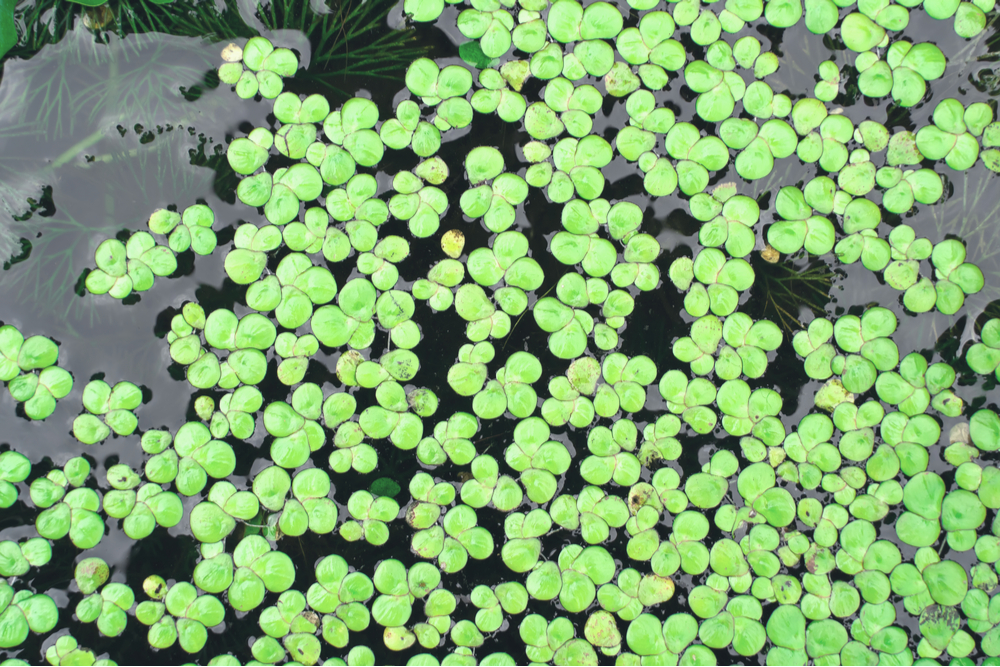
The duckweed family (Lemnoideae) includes a wide variety of flowering plants that float on top of the water. It is natural to find them above slow-moving bodies of water, giving the impression of swamps.
The leaves and stems are absent. Instead, there are “fronds”, which are usually filled with air to help them float. Depending on the species, roots may or may not be present.
It creates shaded areas because it floats on the surface. In stressful situations, your Bettas will often seek out spaces with dim lighting.
The ability of Duckweed to absorb nutrients is also one of its advantages. A lot of nutrients are absorbed by it as it proliferates. By doing this, you can keep your aquarium in better condition.
There are, however, a few problems associated with Duckweed as well. Almost any condition will allow it to grow. As soon as it is established, it can spread quickly across the surface and block out light for plants and fish below. If left unchecked, it can quickly get out of control.
Duckweed should be dealt with as soon as possible. Once you’ve placed it in your aquarium, you may have difficulty removing it. Several plants will grow from one within a few days. Regular tending is necessary to maintain a proper equilibrium.
Amazon Frogbit
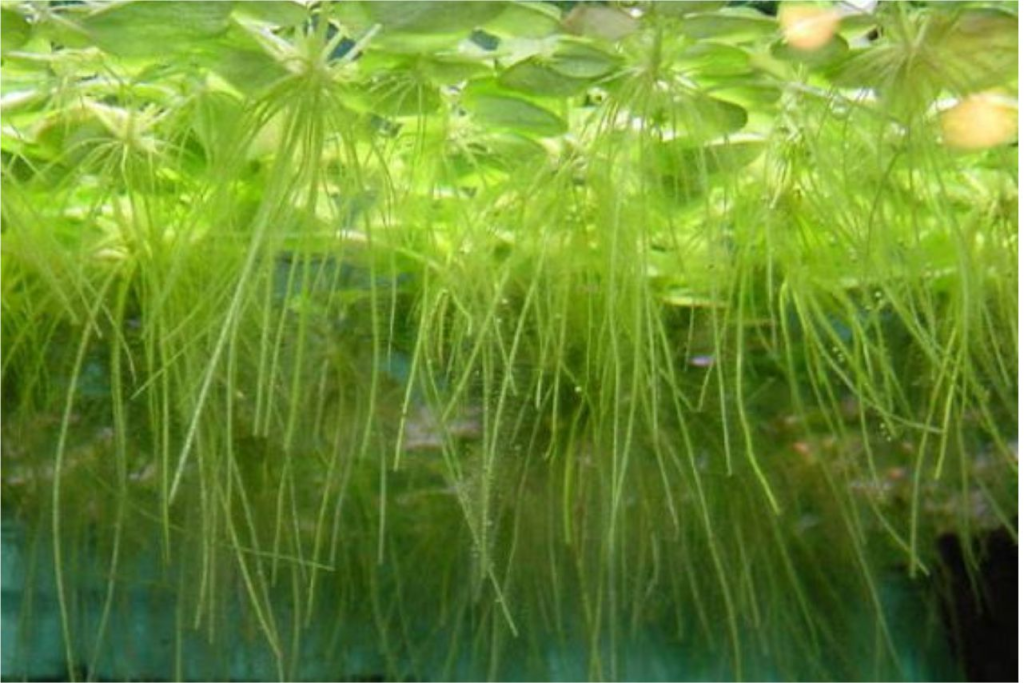
Compared to Duckweed, this is an excellent alternative. This plant creates a canopy similar to Amazon Frogbit (Limnobium laevigatum), but it is much easier to maintain and control.
Rather than having round, large leaves (as in lily pads), this plant has large, circular leaves that form a layer and block out light from below. If it grows slowly, it is less likely to completely take over the tank’s top.
In addition to feeding, mating, and sometimes breathing (with their labyrinth organs), Bettas need plenty of access to the surface.
A South American species of frogbit is the Amazon Frogbit. Although these plants are far away from Asian Betta populations, they will still enjoy the security they provide.
A similarity between Duckweed and this species is that it consumes a lot of nutrients, allowing the aquarium water to be cleaned. Algae levels will also be kept low through this method.
There are some exceptions, however, such as snails. Amazon Frogbit’s underside is popular with these creatures. Plants should be placed in the centre of the aquarium surface so that snails cannot reach them.
Java Fern
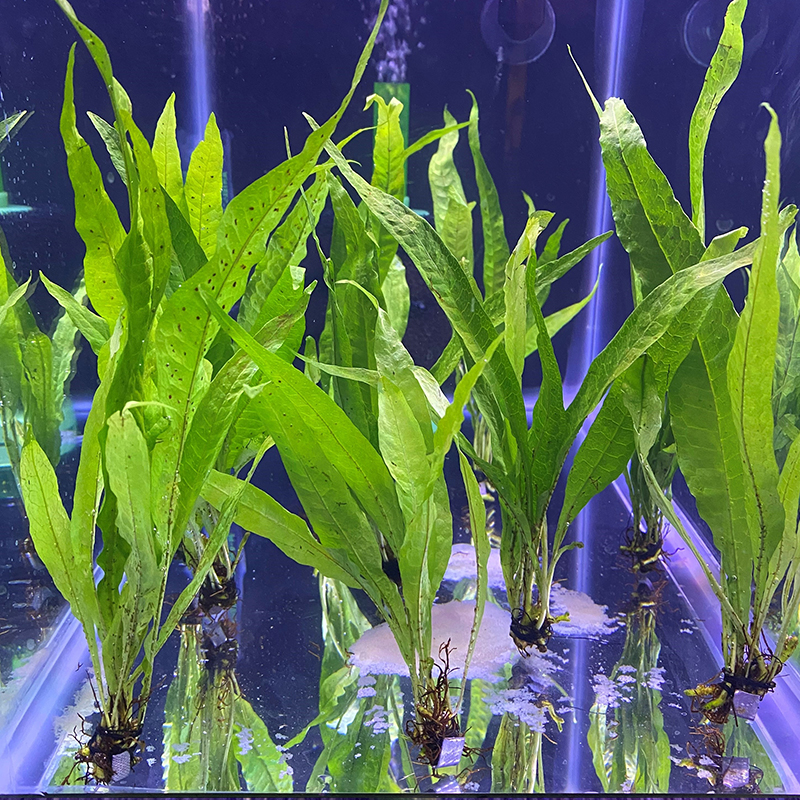
A Java fern is commonly found in aquariums as Microsorum Pteropus. Freshwater systems in Southeast Asia harbour this species, which attaches to rocks and other surfaces.
Its popularity may be attributed to how well it is cared for. Because it can tolerate many conditions, it is straightforward to take care of. Moreover, if something goes wrong in your setup, it is resistant to sudden changes in its environment.
Due to its slow growth, this species requires little maintenance. Generally, it doesn’t need to be trimmed regularly.
As well as its appearance, it attracts people. A powerful green dominates the leaves. The leaves tend to appear darker under brighter lighting. Spiky leaves are typical, but bushy leaves are also common.
Rhizomes are hair-like strings that anchor them to the substrate. Rhizomes can be divided and planted separately if you want to propagate the plant.
It is a favourite shelter for Bettas, and they may claim it as their territory. If the fish are stressed and boisterous, it is a good escape from high light levels.
If you keep fish-damaged plants, you can choose them as well. The thick, robust leaves of these plants are usually unattractive to fish.
Anubias Nana

Among the varieties of Anubias barteri, a freshwater plant found on African riverbanks, Anubias nana is one. Depending on the level of submersion, it can grow partially or fully submerged, making it an ideal plant for a paludarium.
Only 7.5 inches is the maximum height of this plant. Although a Betta will frequently return to the leaves to hide, this is sufficient for him to do so.
Having a volume of only 10 gallons, it can be used in Betta tanks as small as that.
There are similar reasons why this plant is popular as most others. The plant is hardy but will not require much of your attention. When light is available, it will take care of itself.
Beginners can significantly benefit from this since they don’t feel competent yet, so they want to focus on their fish.
Although Anubias Nana has a thick stem, it maintains its structural integrity. The classic teardrop-shaped leaves create the cover. The waxy cuticle on these leaves strengthens them.
You can propagate Anubias Nana quickly through rhizome division if you want to turn a small amount into a lot. Planting a cutting with leaves attached is as simple as taking a cutting and planting it separately.
Species such as this one may be threatened by fish that are known for nibbling plants, like goldfish. Most small fish and plants that complement them should be ok with them.
Java Moss
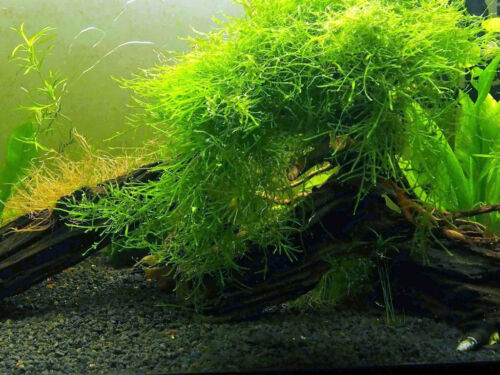
A member of the Hypnaceae family, Java moss is a plant native to Asia. Usually found on rocks and tree trunks by riverbanks, this plant grows on rocks and tree trunks.
Despite being a hardy species, it doesn’t care much about the water conditions or the level of light. Maintaining, adding, and growing it is easy.
The leaves are very short (about 2mm) and attach themselves to surfaces using rhizoids. As a result, it has become famous for aquascaping since it forms a beautiful carpet below the water surface.
Since it attaches so well to surfaces, it can also grow on the wall of your tank. A tree-like decoration can be created by attaching it to driftwood.
The Java Moss will need to be initially tied with the thread. After about a month, you can remove the thread once it has naturally attached itself.
Using scissors, you can shape it as you wish. If you don’t want it to look wild, you can leave it to its own devices.
Adding Java Moss higher up in the tank might be a good idea since Bettas don’t spend much time at the bottom. Because of its short size, it cannot serve as a territory.
Hornwort
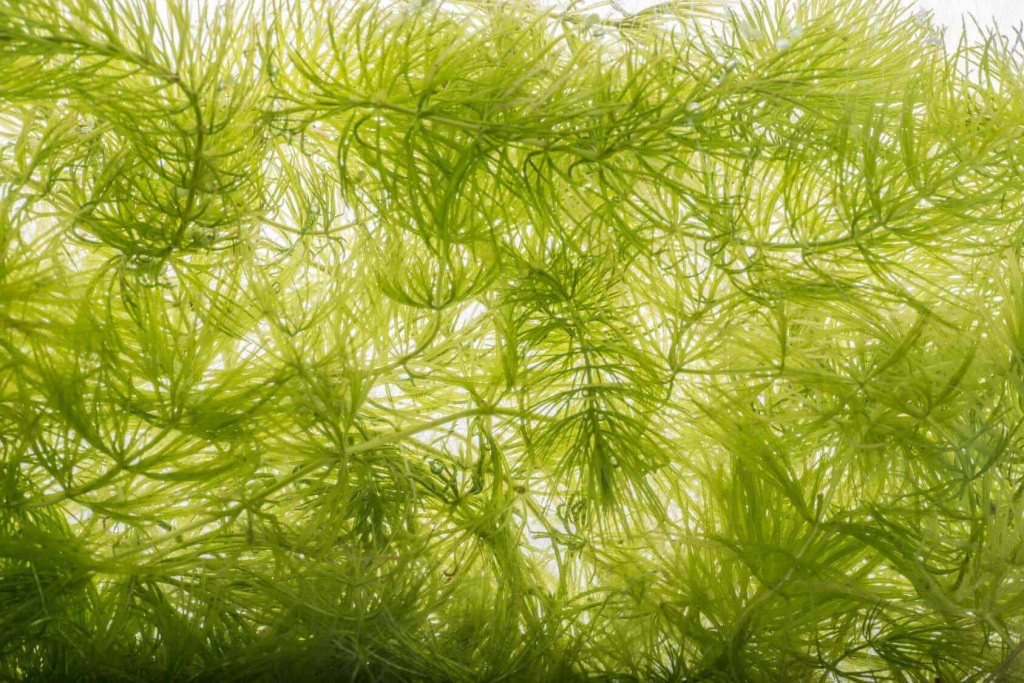
There are some successful aquarium plants, including Hornwort or Ceratophyllum. As you can see from natural populations, over 300 species are incredibly resilient.
All continents except Antarctica have been affected by it since it originated in South America. Due to its rapid growth rate, versatility, and ease of propagation, it is highly successful in the wild.
The exact reasons explain its success in captivity. This species is highly resilient to mistakes, so beginners can feel confident that they can make nearly any mistake. It recovers quickly from damage because of its fast growth rate. This fish species is suitable for keeping plants nibbling fish.
There is nothing better than hiding among hornwort for Bettas. Substrates and water columns are connected by it. A stem can reach a height of 10 feet!
However, regular trimming of the stems is a drawback. An extended period left alone will quickly get out of hand.
The trimmings will grow into tall plants if planted in a different location.
The stems may shed debris sometimes, but the debris will usually be eaten by scavenging fish. Once it has been in the tank for a while, you may be able to remove it yourself.
Amazon Swords

There is much to be learned about this popular plant from its name alone. In particular, the Amazon River basin is home to Amazon swords (Echinodorus grisebachii/amazonicus).
Large, blade-like leaves reach up to 14 inches in length. Their extension from short stems creates bushy appearances. Dark green is a sign of a healthy plant. Dense patches of Amazon Swords well protect bettas. Mating season is when they will defend the area as their territory.
Despite tolerating a wide range of temperatures, the healthiest plants will exhibit the most vibrant colours when growing at 68-75°F.
It’s not necessary to spend much time on Amazon Swords. A healthy tank will keep the plants healthy, so you won’t have to trim them. To grow more plants, you can propagate them quickly. An extended maternal stem produces plantlets. The roots and leaves can be cut off and transplanted to form a new plant once they have developed their roots and leaves.
It may be dangerous for the leaves to be bitten by herbivorous fish. Choose your Bettas’ tank mates carefully since the damage will be evident for a long time.
Anacharis
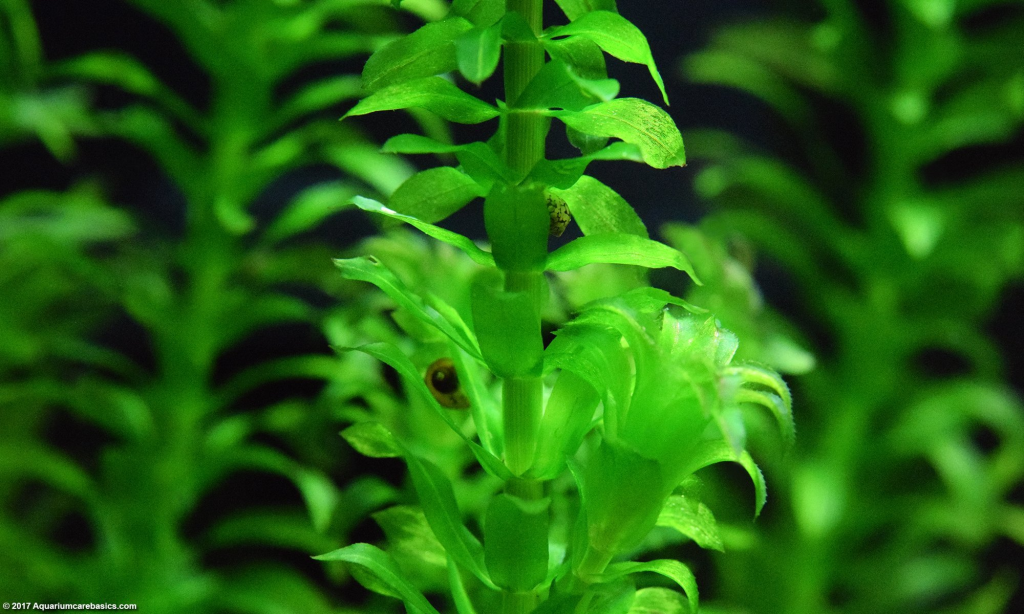
A few names have been given to Anacharis, including Ancharis, Egeria densa (more recently), and Elodea densa. When looking for the plant in stores, look for all these names.
North and South America are its primary habitats. In addition to its native South America, this plant has spread to many other parts of the world.
Aquarists are attracted to the species because it absorbs toxins and nutrients, keeps the water clean, and reduces algae growth.
As they grow upward, these plants spread across the surface, first heading toward the light. To keep your lawn free of dense vegetation, you’ll have to trim them regularly.
In dense areas, bettas will be able to use the shelter as shelter and will defend it from other fishes.
There are short, erect leaves protruding from the stem of Anacharis. Green shades will vary depending on the aquarium’s environment, but the most common aquarium conditions should be acceptable.
If you choose to plant or float it, you have a choice. Keep your Bettas’ surface free of obstructions.
Snails and fish will be attracted to the soft leaves, but Anacharis’s fast growth rate makes it easier for it to recover.
Marimo Moss Ball
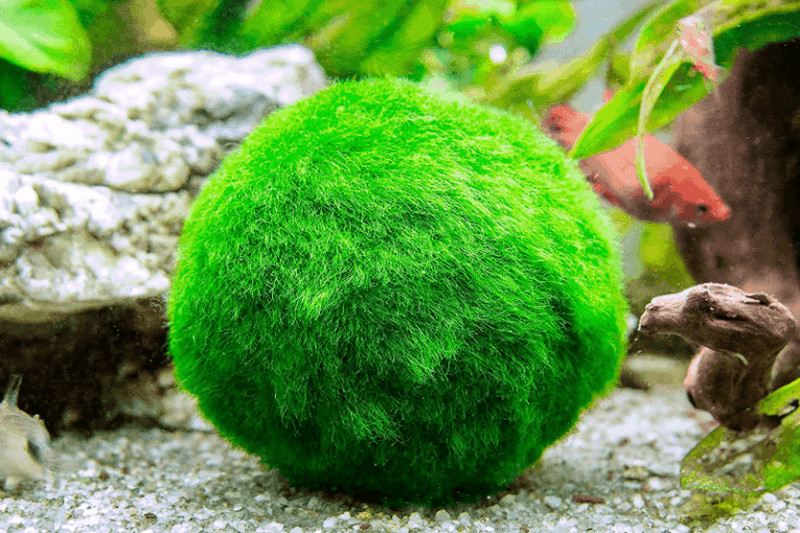
They are a great addition to any aquarium of any size. How long can they live? Did you know it’s possible? Terrariums can be kept as pets.
Betta fish benefit from them because they absorb nitrates and act as natural filters, absorbing ammonia and other harmful phosphates. Marimo moss balls require little light (low to medium, indirect), but they must be rinsed and washed regularly.
Moss balls are popular with Betta fish because they can be rolled around like a toy, like actual balls. They can also be nibbled on, rested, and hidden around if they wish. The ghost shrimps also enjoy them, making them excellent tank mates for bettas.
Vallisneria
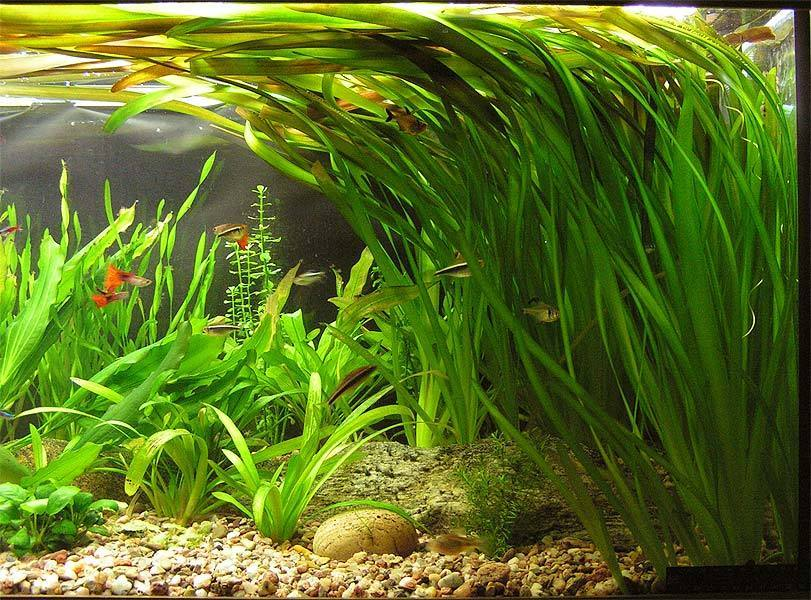
Keeping this plant is also one of the easiest things you can do. Low light conditions will slow its growth, but it will still survive in moderate to high light conditions.
A large amount of hiding spaces is created by its rapid growth, which makes it ideal for betta fish. Plants with dense leaf growths are beautiful and flowing. If their roots are buried too deeply, their health will suffer. Maintain a slight height above the substrate for the crown.
When left unmonitored, Vallisneria can take over the tank and its waters if it propagates through runners from its mother plant. Maintain control by removing runners or trimming Vallis.
Fake Plants, Live Plants and You!
A plant that provides betta fish with good cover hiding places and accommodates a variety of skill levels and time commitments is the best plant for them. Because of their additional benefits, the live plant is preferred over the fake one, but only if it is properly maintained. You can choose the option that is most suitable for you.
Before introducing new live plants into your betta fish’s tank, quarantine them in a separate tank for 1-3 weeks. By doing so, potential diseases and other bacteria can be reduced or eliminated. If your betta needs medication treatment, move it to a hospital tank. Plants can be damaged or even killed by a lot of medicines. If you don’t do so, you may end up paying a high price.
There are all kinds of Betta fish plants, from small to large, from colourful to time-consuming.
Conclusion
It is important to note that many other suitable plants are available for Bettas, in addition to what we have covered here, but this selection is a great place to start when deciding.
Your decision will generally be based on what you think will best suit your tank aesthetically, but you should also consider a few other factors.
Do you think it will survive the water conditions in your tank? Does it require a lot of maintenance? Do you think you can propagate it? Where will it fill the tank?
Different plants are suitable for different people, so there is no correct choice. Any Betta species you choose will be appreciated in your tank by your Bettas.
FAQs
Is there a particular plant that Betta fish need?
Plants provide hiding and resting areas for Betta fish, which replicate their natural habitat. Under normal circumstances, betta fish are shy and skittish, despite their fighter fish name. A community or divided tank with plants provides extra safety and reduces stress.
Are there any plants that Betta fish shouldn’t eat?
It is common for Bettas to be sold in glass vases with peace lilies or bamboo, neither of which are aquatic. As the plants slowly die and decompose, their environment will become poisonous for the betta.
What is the recommended number of plants for a betta?
Using only two or three different plant species is best to create a natural-looking habitat. When the tank is partially filled with water, it is often easier to plant these plants.
Is it possible for plants to cause illness in betta fish?
The Betta Fish eat roots if they feel sick or if their ammonia levels are high, even though some are toxic plants. Betta Fish are carnivores and will only nibble at plants to test them.
What are the effects of plastic plants on betta?
Is it safe for Bettas to eat plastic plants? Betta fish are usually safe to live in aquarium plants made from soft plastic. If you have plastic aquarium plants, run pantyhose over them to check if they are safe for Betta fish.


